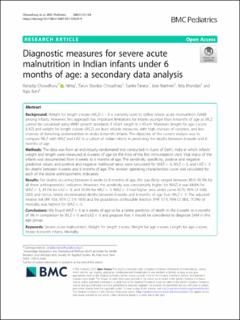| dc.description.abstract | Background
Weight for length z-score (WLZ) < − 3 is currently used to define severe acute malnutrition (SAM) among infants. However, this approach has important limitations for infants younger than 6 months of age as WLZ cannot be calculated using WHO growth standards if infant length is < 45 cm. Moreover, length for age z-score (LAZ) and weight for length z-score (WLZ) are least reliable measures, with high chances of variation, and less chances of detecting undernutrition in under 6 months infants. The objective of the current analysis was to compare WLZ with WAZ and LAZ in a cohort of Indian infants in predicting the deaths between 6 weeks and 6 months of age.
Methods
The data was from an individually randomized trial conducted in slums of Delhi, India in which infants’ weight and length were measured at 6 weeks of age (at the time of the first immunization visit). Vital status of the infants was documented from 6 weeks to 6 months of age. The sensitivity, specificity, positive and negative predictive values, and positive and negative likelihood ratios were calculated for WAZ < -3, WLZ < -3, and LAZ < -3 for deaths between 6 weeks and 6 months of age. The receiver operating characteristics curve was calculated for each of the above anthropometric indicators.
Results
For deaths occurring between 6 weeks to 6 months of age, the specificity ranged between 85.9–95.9% for all three anthropometric indicators. However, the sensitivity was considerably higher for WAZ; it was 64.6% for WAZ < -3, 39.1% for LAZ < -3, and 25.0% for WLZ < -3. WAZ < -3 had higher area under curve (0.75; 95% CI: 0.68, 0.82) and hence, better discriminated deaths between 6 weeks and 6 months of age than WLZ < -3. The adjusted relative risk (RR 10.6, 95% CI 5.9, 18.9) and the population attributable fraction (PAF 57.9, 95% CI 38.8, 71.0%) of mortality was highest for WAZ < -3.
Conclusions
We found WAZ < -3 at 6 weeks of age to be a better predictor of death in the 6 weeks to 6 months of life in comparison to WLZ < -3 and LAZ < -3 and propose that it should be considered to diagnose SAM in this age group. | en_US |

